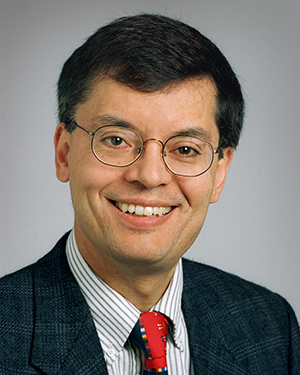Research News
12/16/2020
Study Reveals How Improved Type of Light Therapy Kills Pre-Cancerous Cells
Dr. Maytin and colleagues developed a less painful but equally effective form of photodynamic therapy to treat pre-cancerous actinic keratosis, demonstrating that it works through a completely different signaling pathway than the conventional therapy.

In a set of publications authored this year, Department of Biomedical Engineering researchers developed an improved approach for treating a skin condition caused by sun damage, called actinic keratosis, and showed how the therapy works on a biological level.
Actinic keratosis is the most common form of pre-cancer caused by long-term exposure to dangerous ultraviolet light, as might result from using an indoor tanning bed or spending time outside without a hat and sunscreen. Left unchecked, this condition can progress to a type of malignant cancer called squamous cell carcinoma.
Actinic keratosis is usually treated with photodynamic therapy (PDT), in which light energy of a certain wavelength is used to activate a topical liquid medication (called a photosensitizer) that is applied to the affected area of skin. While PDT is effective at killing the pre-cancerous cells, patients report the illumination phase of the treatment to be very painful. The burning and stinging pain it causes can lead patients to avoid future treatments.
Clinical trial validates the effectiveness of an alternative therapy
In April, the research team, led by Edward Maytin, MD, PhD, published in the Journal of the American Academy of Dermatology results from a controlled, randomized clinical trial showing that a newer, less painful regimen of photodynamic therapy—called painless photodynamic therapy (p-PDT)—was just as effective as the conventional treatment, with patients reporting significantly less pain.
The primary difference between the conventional therapy and Dr. Maytin’s p-PDT is the time between application of the photosensitizer—here, a liquid containing 20 percent of 5-aminolevulinic acid—and light. In the conventional regimen, the medication is applied and sits on the skin for an hour or more before light is applied, whereas in p-PDT, the light therapy begins immediately following application of the medication.
Why p-PDT is less painful remains unknown, although a likely reason is that the shorter window of time prevents the medication from reaching sensitive nerve endings, while still being absorbed by pre-cancerous cells in the skin.
The power of immune cells versus free radicals
Sanjay Anand, PhD, a project scientist in the Maytin lab, led a mechanistic study, recently published in Photochemistry and Photobiology, to better understand how p-PDT’s milder, less painful regimen could clear pre-cancerous lesions as effectively as the more intense, conventional regimen.
The team treated preclinical models of actinic keratosis with both forms of therapy. After two weeks, they biopsied the lesions, revealing that p-PDT increases the production and recruitment of a host of immune cell types—including neutrophils, macrophages and T cells—and that this engagement of the immune system causes tumor death.
“The results of our study demonstrate that p-PDT is an effective therapy for actinic keratosis,” said Dr. Anand. “We also discovered that its effectiveness is due to a completely different signaling pathway than conventional PDT.”
They showed that while conventional PDT primarily produces free radicals (also called reactive oxygen species), which damage the pre-cancerous cells’ genetic material and directly cause cells to die, p-PDT uses a different mechanism that attracts and activates cells involved in anti-tumor immunity.
Dr. Maytin is optimistic about the painless therapy’s therapeutic potential. “Our investigation has laid the groundwork for a more detailed investigation into p-PDT. Our findings may also help direct future investigations into whether or how reactive oxygen species contribute to pain.”
This study was supported by the National Cancer Institute, part of the National Institutes of Health. Dr. Maytin is a practicing physician-scientist jointly appointed in the Dermatology & Plastic Surgery Institute and in the Department of Biomedical Engineering.
Featured Experts
News Category
Related News
Research areas
Want To Support Ground-Breaking Research at Cleveland Clinic?
Discover how you can help Cleveland Clinic save lives and continue to lead the transformation of healthcare.
Give to Cleveland Clinic